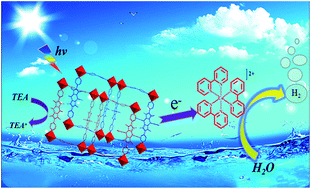A noble-metal-free photocatalyst system obtained using BODIPY-based MOFs for highly efficient visible-light-driven H2 evolution†
Abstract
The development of noble-metal-free photocatalyst systems based on metal–organic frameworks (MOFs) is very imperative and demanding. In this study, by employing a pyridine-functionalized boron dipyrromethene (BODIPY) linker as both a light-harvesting antenna and an organic strut in the presence of 4,4′-biphenyldicarboxylic acid (H2BPDC) or 4,4′-sulfonyldibenzoic acid (H2SDB), two MOFs, namely [Cd2(BODIPY)2(BPDC)2] (denoted as CCNU-11, CCNU = Central China Normal University) and [Cd2(BODIPY)2(SDB)2] (CCNU-12), with identical topological structures and same redox levels could be reliably synthesized; in the presence of tris(bipyridine)cobalt ([Co(bpy)3]Cl2), CCNU-11 exhibited the excellent photocatalytic activity of 60.4 mmol g−1 h−1, whereas CCNU-12 exhibited the activity of 44.6 mmol g−1 h−1 under visible illumination (λ > 420 nm) in the presence of triethylamine (TEA) as a sacrificial reagent. These remarkable values are among the highest reported to date for MOFs with proton reduction co-catalysts. Moreover, the higher photocatalytic efficiency over CCNU-11 + [Co(bpy)3]Cl2 system probably originates from the pore characteristics within CCNU-11. This study provides fundamental insights into the role of porosity in the photocatalytic performance and is likely to inform the ongoing efforts towards the exploitation of noble-metal-free photocatalytic systems based on BODIPY-based MOFs for highly efficient and long-term solar fuel production.



 Please wait while we load your content...
Please wait while we load your content...